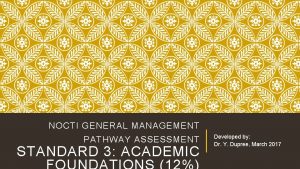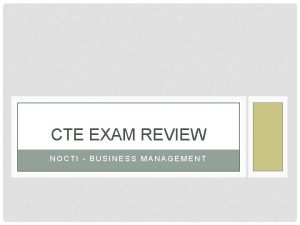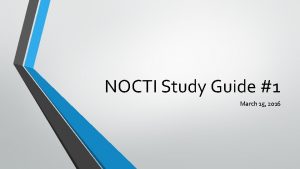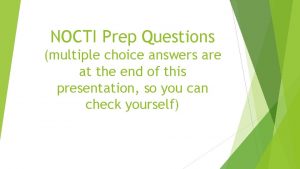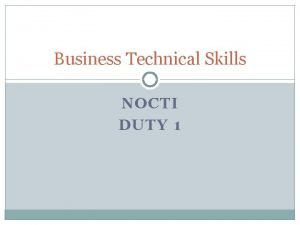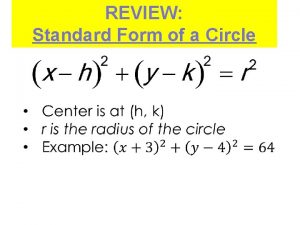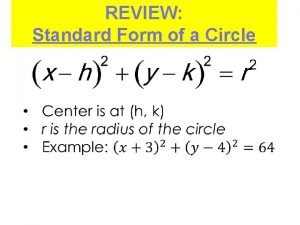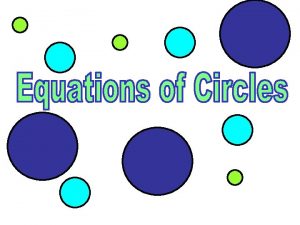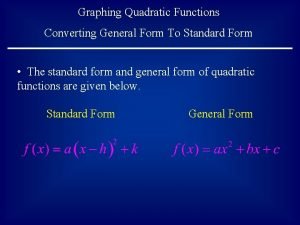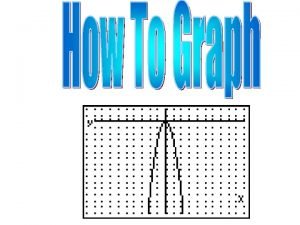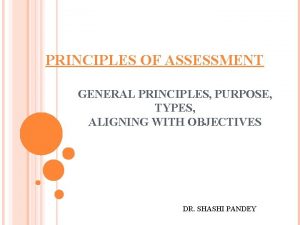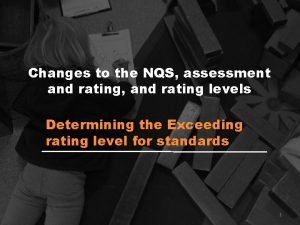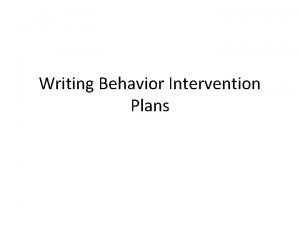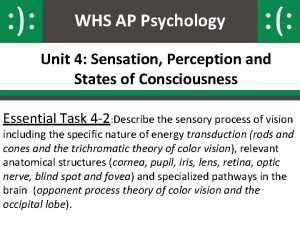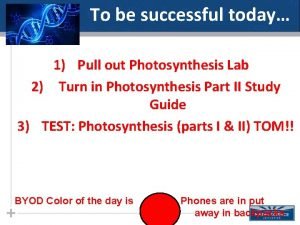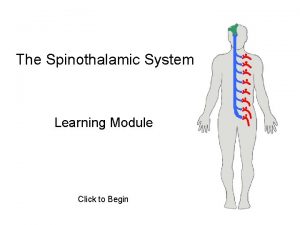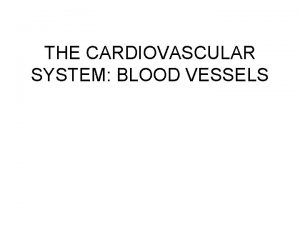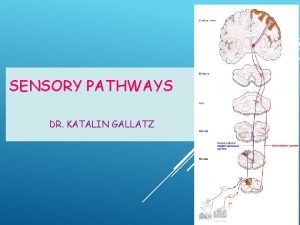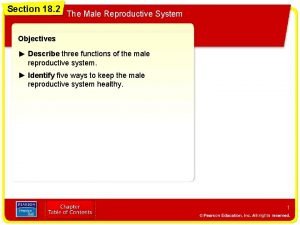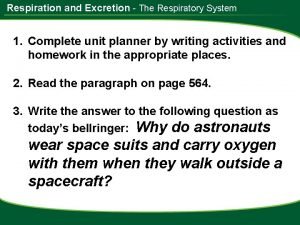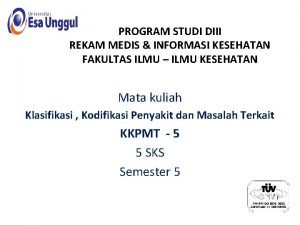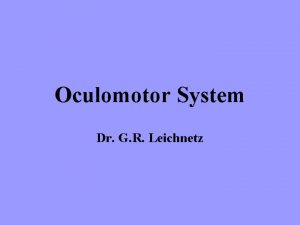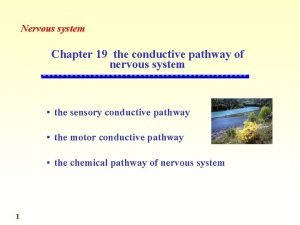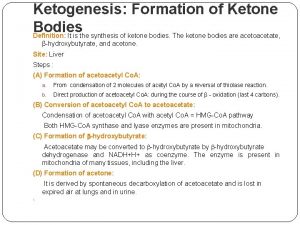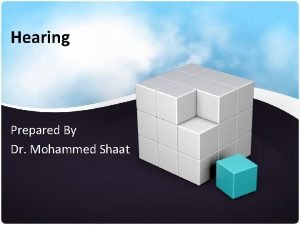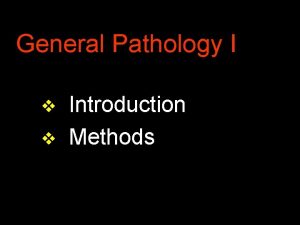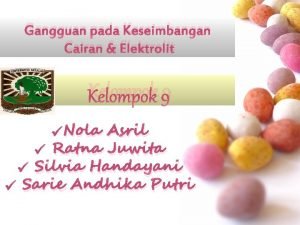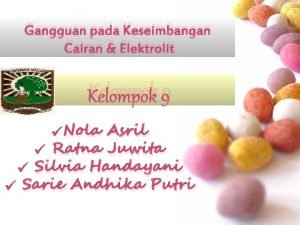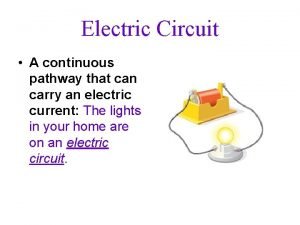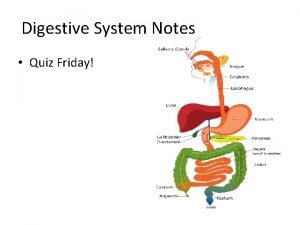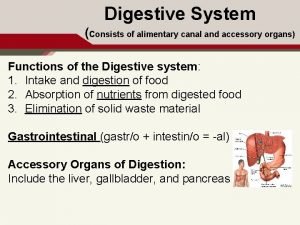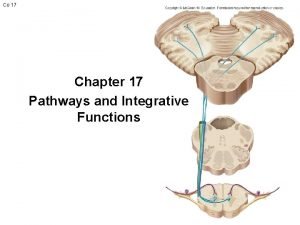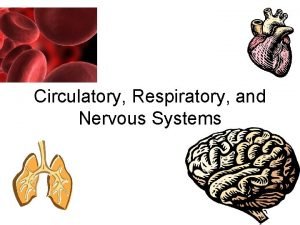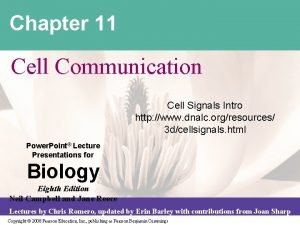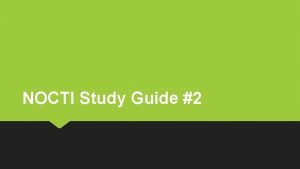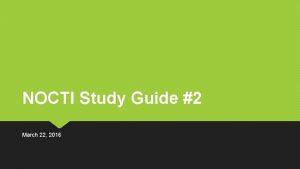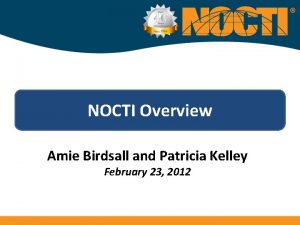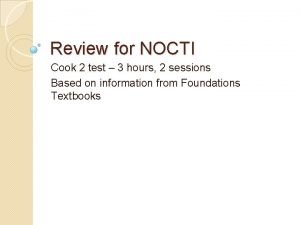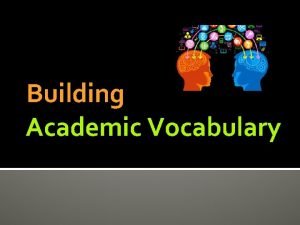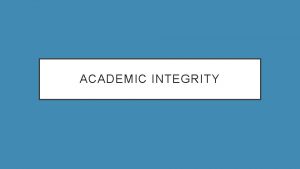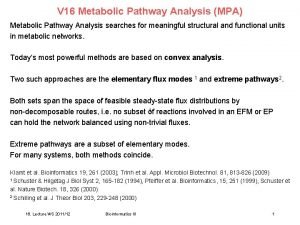NOCTI GENERAL MANAGEMENT PATHWAY ASSESSMENT STANDARD 3 ACADEMIC









































































































- Slides: 105

NOCTI GENERAL MANAGEMENT PATHWAY ASSESSMENT STANDARD 3: ACADEMIC Developed by: Dr. Y. Dupree, March 2017

BE PREPARED This resource has been developed to prepare you for your EOPA which will be your final exam grade (20% of your final grade). Assessment information It is an online assessment Must score a 70% or higher in order to pass You will need: a basic calculator Time/Length: 2 hours/ 107 -110 multiple-choice questions

TESTING TAKING TIPS Read each question carefully. Watch for details. Don’t rush! Answer every question. Don’t change your answers unless you know for sure it is wrong. The answer which comes to mind first is often correct. Nervously reviewing questions and changing answers can do more harm than good.

WHY IS THIS IMPORTANT? What are the benefits of passing the EOPA? Tests specific competencies and Proves that you have the knowledge and the skills businesses want skills because it is based on industry Measures your comprehension standards What is the purpose of the EOPA? and application of critical business skills You can add this to your resume You will earn a globally recognized industry credential You are recognized for 3 years of hard work!

YOU CAN DO IT! YOU WILL PASS THIS ASSESSMENT! Our goal: 100% Pass rate

AS YOU PROGRESS THROUGH THE LESSON • Read through/listen to the video in its entirety • Visit websites and watch the videos embedded by following the hyperlinks • Take handwritten notes on a sheet of paper – IN YOUR OWN WORDS • Review the material throughout • Test Your Knowledge • Review Questions • Write down any questions that you have • For further research • For Dr. Dupree • Create 2 original multiple-choice test questions for the standard

AFTER COMPLETING THIS LESSON YOU SHOULD BE ABLE TO: • Apply reading skills in a business environment • Apply writing skills in a business environment • Apply mathematical skills in a business environment • Apply economic skills in a business environment

APPLYING READING AND WRITING SKILLS IN A BUSINESS ENVIRONMENT

READING SKILLS Reading and interpreting written material Reading manuals and policy documents Reading information and being able to revise if necessary Understanding and comprehending material Reading skills are one of the most important skills to have because if you know how to read you will be able to figure out and understand everything more clearly

LITERACY IS IMPORTANT FOR SUCCESS IN BUSINESS LITERACY INCLUDES: Reading with comprehension and writing Writing Speaking Using media and technology

WRITING SKILLS Ability to write simple business letters and memos. Ability to compose proper emails for business. Ability to create an agenda, presentations, etc. Ability to write accurate documentation into databases etc.

ESSENTIAL COMPONENTS OF EFFECTIVE WRITING Spelling Punctuation Capitalization Grammar Also pay attention to format and spacing for business docs

IMPORTANCE OF WRITING SKILLS IN BUSINESS It doesn’t matter what type of business


REVIEW QUESTIONS Which of the following words is misspelled? Which of the following sentences is grammatically correct? A. perpetuity A. The accident victim was laying on the road until the ambulance arrived. B. annuity C. allocate D. deversification B. We arrived their at 3 PM to begin the meeting. C. The manager busted into the wrong office by mistake. D. Ann missed the meeting because she was lying in bed with the flu.

BUSINESS CORRESPONDENCE Business Communication and Presentation

WHAT IS BUSINESS CORRESPONDENCE? A written message that deals with business matters. Purpose of business correspondence: Promote goodwill Provide a record Advise, direct or state a policy Inform Request information or reply to requests Persuade

PROMOTE GOODWILL Goodwill – a positive feeling about others or the positive reputation or image of an organization. Helps attract and keep customers Encourages good working relationships

PROMOTE GOODWILL All business correspondence should promote goodwill: Always be polite and courteous Always tell the truth, even if it is bad news Examples of correspondence topics where goodwill is the main purpose: Thank you Congratulations/acknowledgment Apology

PROVIDE A RECORD Record – a document of events that have occurred or of things people have said. Why is it important? Answers questions that may come up later. Provides feedback of understanding. Provides proof of events or conversation.

PROVIDE A RECORD Example of providing a record: The manager tells you in the hallway to stop work on an important project. You send the manager an e-mail with this message: “following your direction, I have stopped work on the project until further notice. “ Now you and the manager have a record of the conversation in the hallway.

ADVISE, DIRECT, OR STATE A POLICY Specific types of information in correspondence are very common: Advise – suggestions of how to solve a problem Direct – give an assignment for a task State a Policy – explain the organization’s procedure or position on a specific task or behavior.

ADVISE, DIRECT, OR STATE A POLICY Example of correspondence to advise: The car sales representative sends a letter to a customer with tips on how to get the most gas mileage from a vehicle recently purchased. Example of correspondence to direct: The administrative assistant receives an e-mail from the manager directing him to make travel arrangements for an upcoming trip. Example of correspondence to state a policy: The manager sends a memorandum to all employees announcing the new smoke-free policy in the building.

INFORM Inform – tell others about a topic or event. Example of correspondence to inform: The information systems director sends an e-mail to all employees stating that the company website will be shut down between 2 and 5 a. m. Sunday morning for updates.

REQUEST OR REPLY Request for Information – correspondence to seek an answer to a question. Example: You send an e-mail to a co-worker asking what time an event will take place. Reply with Information – correspondence that gives an answer to a question. Example: The manager asks you what his travel itinerary will be next week. You send him a memo with the information.

PERSUADE Persuade – using supporting arguments to seek action or agreement on an idea. Example of correspondence to persuade: The sales office sends a letter to all customers urging them to place orders early to take advantage of price discounts.

COMMON METHODS OF DISTRIBUTING CORRESPONDENCE Print Mail – sent by U. S. Post Office, or private carriers, such as Fed. Ex or UPS Interoffice Mail – a system of delivering printed material within an organization. Delivery – distributed by employee or messenger service Electronic Sent as an e-mail, or as an e-mail attachment over the Internet

COMMON FORMS OF BUSINESS CORRESPONDENCE Memorandum (memo) E-mail Letter

MEMORANDUM Often called “memo” Official document sent to persons within an organization, such as employees or board members May be printed or sent electronically as an e-mail attachment Length: varies from one paragraph to several pages. Formatted according to the organization’s standards.

PARTS OF A MEMORANDUM Document Title Heade r Body

GENERAL MEMORANDUM FORMAT Use the tab key to align the heading content Document title identifies correspondence as a Memorandum Sign your initials by your name to authenticate a printed memo The message here explains how the body of the memo is formatted.

E-MAIL Informal message sent on a computer. May be sent to persons within or outside organization. Today used more often than memos for correspondence within an organization. Length: very brief If the message is long, use the e-mail to introduce and attach a memorandum. Follow organization’s e-mail policy

E-MAIL FORMAT Each e-mail provider will have a slightly different look or design, but the parts are essentially the same. The parts of an e-mail are similar to the parts of a memorandum.

PARTS OF AN E-MAIL Header CC: Courtesy Copy BC: Blind Copy Greeting Body Complimentary Close Signatur e

WHAT ARE CC: AND BC: IN AN E-MAIL HEADER? CC: and BC: or BCC: are additional address lines CC: Courtesy copy (or Carbon Copy) send to another party to make them aware of the message between the sender and receiver(s). The CC: address appears in the receiver’s e-mail. BC: Blind copy or BCC: Blind Carbon Copy same as CC: but the address is NOT on the receiver’s e-mail. Receiver is unaware that someone else is receiving a copy.

E-MAIL FORMAT Subject line is meaningful Greeting and closing lines are used in more formal correspondence, such as e-mail to a customer

E-MAIL DO’S AND DON’TS Do’s Don’ts Use a courteous tone Use phrases that can be misunderstood Provide a meaningful subject line Use a greeting and closing for more formal correspondence Keep the message brief Attach documents if message is lengthy Use all caps, or excessive underline, which may be interpreted as yelling. Use slang or emoticons Create a lengthy message Frequently use company e-mail for personal correspondence

E-MAIL IS NOT PRIVATE! Even if you are sending an e-mail to only one person – the message may be saved, printed, or forwarded to someone else. Write only what you would permit the entire business staff to read…your email could be easily be forwarded to them all! Don’t send an e-mail in anger. You may regret later the harsh words you write. Also, your e-mail can serve as evidence of harassment.

LETTER Formal printed message sent to persons outside and within an organization. Business Letter – sent by a business or organization Personal Business Letter – sent by an individual to a business or organization

BUSINESS LETTER Sent from a business or organization Typically printed on high quality stationery that includes a letterhead. Letterhead – business logo, address, telephone number, and other contact information is designed in an attractive manner to appear on the first page of business letters. Letterhead may be pre-printed on paper, or saved on the computer as a template

BUSINESS LETTER FORMAT (1) Block Style, mixed punctuation is the most common Block Style: All lines are aligned left and single-spaced within paragraphs, double spaced between paragraphs and quadruple spaced after heading and complementary close. Mixed Punctuation: A colon (: ) is used after the salutation (Dear Mr. Jones: ); a comma (, ) is used after the complimentary close (Sincerely, ) The generally accepted font is Times New Roman, 12 point.

BUSINESS LETTER FORMAT (2) Typists initials: If the letter is typed by someone other than the person signing the letter, the typist’s initials are keyed in lower-case following a double space under the printed name of the signer. Enclosure line: if other documents will be enclosed with the letter, key the word, “Enclosure” following a double space under the printed name of the signer.

BUSINESS LETTER FORMAT (3) Letterhead contains business logo, or name, and contact information in a pleasing design Letter is formatted according to business standards: block style, mixed punctuation After the letter is printed, it will be hand signed in blue or black ink above the printed name

PARTS OF A BUSINESS LETTER Letterhead Date Line Inside Addres s Salutatio n Body Complimentary Close Signature Block (signature line + job title)

PERSONAL BUSINESS LETTER Sent from an individual to a business or organization Printed on paper above the quality of copy paper An individual typically does not have letterhead Sender types address information Formatted according to business letter standards

PERSONAL BUSINESS LETTER FORMAT 2 inch top margin Instead of a letterhead, sender’s address is typed, followed by a double-space and the date. After printing, the letter will be hand signed in blue or black ink above the signature line. Letter is formatted according to business standards: block style, mixed punctuation.

PARTS OF A PERSONAL BUSINESS LETTER Return Addres s Date Line Inside Addres s Salutatio n Body Complimentary Close Signature Line

READING COMPREHENSION QUIZ Click on the link in presentation mode: Business Correspondence Practice EOPA http: //www. quia. com/quiz/5262611. html

TEST YOUR KNOWLEDGE Letter A written, typed, or printed communication. In addition, a letter is usually a from one company to another, or between such organizations and their customers, clients and other external parties. The overall style of letter depends on the relationship between the parties concerned. Interoffice Memorandum An informal message, especially one sent between two or more employees of the same company, concerning company business. **

TEST YOUR KNOWLEDGE What are Some Do’s for Writing Business Correspondence? YOUR NAME HERE § Type all formal correspondence Your Address Date: § Always date your business correspondence Person addressed to Address § Use names and titles appropriately Dear_______, § Be direct and positive Letter Introduction § Be persuasive and specific Body of Letter § Be polite § Use an appropriate closing § Proofread for spelling and grammar errors To: All Employees From: § Be sure to spell all names correctly and have the correct address § Avoid using fancy words Memorandum Closing Sincerely, Name here Date: Re: Type Message here

TEST YOUR KNOWLEDGE Block Format Business Letter YOUR NAME HERE Your Address Date: What type of business correspondence is this? Person addressed to Address Dear_______, Letter Introduction Body of Letter Closing Sincerely, Name here

TEST YOUR KNOWLEDGE Memorandum What type of business correspondence is this? To: All Employees From: Date: Re: Type Message here


How to Write an Agenda for a Meeting

CREATE A PROFESSIONAL PRESENTATION – USING PPT, PREZI, EMAZE, ETC Everything should be easy to read and understand! Absolutely no spelling, grammar, punctuation, and capitalization mistakes! Avoid busy backgrounds (examples: textures, patterns, and pictures) Choose colors wisely Create contrast between the text and the background With light backgrounds use dark text (black, blue, etc) With dark backgrounds use light text (white, yellow, etc) Font (text) should be easy to read Avoid script/cursive fonts Choose the correct font size (Size 30 or larger if for a presentation) Add relevant images and/or shapes Do not use blurry or distorted pictures Use charts and tables to simplify info when possible Create a simple message with a few key points (Keep it Simple) Do not plagiarize (i. e do not simply copy and paste info - put it in your own words) Follow copyright rules Always give credit

ADDITIONAL TIPS FOR POWERPOINTS AND OTHER PRESENTATION TOOLS 1 main idea per slide Remember the 7 X 7 Rule (or 6 X 6 or 5 X 5 whichever you prefer but be consistent) Avoid blocks of text and sentences whenever possible Remember it’s Power. Point not Power. Paragraph Use Font Size 30 pt or larger Do not over animate Animate for emphasis Be careful with transitions If setting a timer be sure that you will have enough time (set to advance “on mouse click” instead)

ADDITIONAL TIPS IF USING SOUND OR CONVERTING TO A VIDEO Speaking parts should be clear, easy to hear, and understand Consider adding music (instrumental) if no one is speaking throughout the video Music should relate to and/or fit with the video

BE FAMILIAR WITH THE MICROSOFT OFFICE SUITE

Microsoft Office Computer Program (Similar Google Product) Type of Application What it does? /Primary Function Microsoft Outlook Personal Information manager (Email application) Mainly email application it also includes a calendar, task manager, contact manager, note taking, journal, and web browsing Microsoft Publisher Desktop Publishing entry-level desktop publishing application differing from Microsoft Word in that the emphasis is placed on page layout and design rather than text composition and proofing Create: business cards, greeting cards, calendars, newsletters Microsoft Word (Google Docs) Word Processor Typing up documents Create: letters, memos, notices, fax cover sheets and envelopes for mailing or distribution Newsletters, brochures and books graphs, photographs, charts, drawings and tables can be inserted Microsoft Power. Point (Google Presentation Slides) presentation software program Pictures, graphs, video and sound can all be integrated into the presentation Microsoft Excel (Google Sheets) Spreadsheet spreadsheet program used to store and retrieve numerical data in a grid format of columns and rows Ideal for entering, calculating and analyzing company data such as sales figures, sales taxes or commissions. creating numerical formats and visual data Although Word has some graphical and calculation capability, Excel offers far more tools for calculating trends, deciphering profits Microsoft Access Database database management system (DBMS)

WORKING WITH DATABASES Database Design Basics

APPLYING MATHEMATICAL SKILLS IN A BUSINESS ENVIRONMENT

BASIC MATH SKILLS THAT ARE IMPORTANT IN BUSINESS Addition Subtraction Multiplication Division

MATHEMATICAL SKILLS You must be able to: calculate simple percentages add and subtract with excel or other spreadsheets deductively determine if a number looks way off Determine taxes on purchases use excel and formulas to figure out monetary figures and future possibilities Be sure that you know how to perform the calculations above (see subsequent slides for related information) Suggested: Complete the Odysseyware lessons on Math skills

HOW TO CALCULATE SIMPLE PERCENTAGES

ANNUAL PERCENTAGE RATE (APR) The annual rate charged for borrowing or earned through an investment, and is expressed as a percentage that represents the actual yearly cost of funds over the term of a loan. This includes any fees or additional costs associated with the transaction but does not take compounding into account. As loans or credit agreements can vary in terms of interest-rate structure, transaction fees, late penalties and other factors, a standardized computation such as the APR provides borrowers with a bottom-line number they can easily compare to rates charged by other lenders. APR vs. Interest Rate An interest rate, or a nominal interest rate, refers only to the interest charged on a loan, and it does not take any other expenses into account. (Investopedia)

HOW TO ADD OR SUBTRACT WITH EXCEL

DETERMINING TAXES Determining Sales Tax

RELATED VOCABULARY Gross income (also commonly referred to as gross pay) Gross pay is the total amount of money you earned before taxes or other deductions are subtracted from your salary. Net income (also referred to as Net pay) Most paycheck stubs have a line devoted to net income. This is the amount that appears on an employee's check (your take home pay). It consists of gross income, minus taxes, retirement account contributions, and other voluntary withholdings

BUSINESS MATH

SALES REVENUE Sales revenue is the amount of money that is brought into the business from the sales of products and/or services over a period of time. Sales Revenue = Units Sold x Sales Price When sales revenue decreases, it can affect all aspects of the company. If the amount of money coming into the business decreases, other cuts must be made in payroll, expenses, and resources. When sales revenue increases, more money is coming into the business, and extra cash flow may be available for debt reduction, expansion, and perks for the employees.

PROFIT Profit is the money a business makes after accounting for all expenses. Profit is a financial benefit that is realized when the amount of revenue gained from a business activity exceeds the expenses, costs and taxes needed to sustain the activity. Consistently earning profit is every company's goal Any profit that is gained goes to the business's owners, who may or may not decide to put it back into the business. Profit = Total Revenues – Total Expenses

NET INCOME By subtracting your revenue from your expenses, you can calculate your net income. This is the money that you have earned at the end of the day. It’s possible that this number will be negative when your business is just beginning, so the goal is for your business’ net income to become positive, meaning your business is profitable. Net Income = Revenues – Expenses Related Vocabulary: Revenues are the sales or other positive cash inflow that comes into your company. Expenses are the costs that are associated with making sales or doing

REVIEW QUESTION

REVIEW QUESTION A business owes Bob’s Office Supply Store $2, 500 at the beginning of September. On September 15 th, the business buys an additional $400 worth of merchandise on the credit card. On September 21 st, the firm returns $275 of the merchandise. How much does the business owe Bob’s Office Supply Store on September 30 th? A. $2, 225 B. $2, 695 C. $2, 900 D. $3, 175

REVIEW QUESTION – FINANCIAL MANAGEMENT If total assets increased $35, 000 during a period and total liabilities increased $14, 000 during the same period, the amount and direction (increase or decrease) of the change in owner’s equity for that period is A. $21, 000 increase B. $21, 000 decrease C. $24, 000 increase D. $24, 000 decrease


APPLYING ECONOMIC SKILLS IN A BUSINESS ENVIRONMENT

LAW OF SUPPLY Supply is the quantity producers are willing and able to provide at different prices. The law of supply states that when prices increase, producers provide more, and when prices decrease, producers provide less. LAW OF DEMAND Demand isn’t simply what consumers want. Demand is the quantity consumers are willing and able to buy at different prices. The law of demand states that when prices increase, people buy less, and when prices decrease, people buy more. Producti vity Productivity is a quantitative measure of the relationship between input and output. Total output divided by total input = Total output / total input. Labor productivity is defined as output person per day. Productivity is a measure of the amount of extra output produced resulting from the extra input. There is an increase in productivity if one of two things happens: 1) We can produce more with the same inputs as before 2) We can produce the same amount with less input.

RELATED VOCABULARY Shortage - (or excess demand) is a situation in which the demand for a product exceeds its supply It is the opposite of an excess supply (surplus) Surplus - (or excess supply) an excess of production or when supply exceeds demand

ROLES OF BUYERS AND SELLERS DETERMINING MARKETING CLEARING • The market clearing price or equilibrium price “clears” the PRICE market resulting in a situation • Market Equilibrium is where supply = demand • where there are neither shortages nor surpluses • Transactions in a market economy are voluntary so they must benefit both buyers and sellers

EQUILIBRIUM PRICE AND QUANTITY

PRICE AS AN INCENTIVE AND CONCEPT OF PRICE The price is the amount of money needed to buy a particular good or service. In a market, the price and quantity exchanged are determined by the interaction of demand supply. Changes in demand or supply alter the equilibrium price as well as the quantity bought and sold at that price. Prices provide incentives to both buyers and sellers. For example, if poor weather in Brazil causes a reduction in the supply of coffee and an increase in the price of coffee, then at least some buyers of coffee will react to the higher price by reducing the amount of coffee they drink or by substituting some other drink. If the demand for fresh fruits and vegetables increases, causing the price to rise, then at least some suppliers will react to the higher price by producing more. In this way, flexible and adjustable prices are messengers in a market economy, revealing information on supply and demand conditions and providing incentives for market participants to respond appropriately to that information.


• A business jointly owned by two or more people. • Advantages- ease of start-up, each partner brings a unique skill to the partnership, larger pool of capital, lack of special taxes on partnership itself. • Disadvantages- each partner is fully responsible for partner, unlimited liability for partnerships that are not limited liability partnerships (LLP), limited life, potential for conflict with partners. Corporation • A business owned and run by one person. • Sole proprietorship • Advantages- ease of start-up, ease of management, owner can enjoy all profits, owner has full control, easy to discontinue, business itself is exempt from tax on income. • Disadvantages- unlimited liability (owner is personally and fully responsible for all losses and debts of business), difficulty of raising financial capital, amount of work for one person may be overwhelming, limited life. Partnership Sole proprietorship FORMS OF BUSINESS ORGANIZATION COMPARISON • A business organization that is owned by stockholders and recognized by law as a separate legal entity having all the rights as an individual. • Advantages- ease of raising financial capital through the sale of stock or the issuance of bonds, limited liability for owners, unlimited life, ease of transferring ownership. • Disadvantages- difficult to start, owners/shareholders often have little say in how the business is run, many more legal requirements and regulations, double taxation.

ROLE OF PROFIT AS AN INCENTIVE Entrepreneurs are willing to risk their own resources in order to sell them for financial gain or profits. Entrepreneurs are successful when they provide consumers with goods and services that consumers highly value. Financially successful entrepreneurs have some common characteristics. First, they are willing to assume risk, and high risk can lead to high rewards. Entrepreneurs have unique skills that help them develop new products or new cost-cutting production methods or new ways to serve consumers. Many entrepreneurs also have the discipline to work long and difficult hours to achieve their goals. These same entrepreneurial characteristics can help anyone to be successful even one who doesn't start a business. If you want to earn more income, develop valuable skills and use them in ways that are highly valued by others.

ABSOLUTE AND COMPARATIVE ADVANTAGE Absolute advantage- a country’s ability to produce a certain good more efficiently than another country. An entity can have an absolute advantage in more than one good or service. Absolute advantage also explains why it makes sense for countries, individuals and businesses to trade with one another. Comparative Advantage- The ability of a firm or individual to produce goods and/or services at a lower opportunity cost than other firms or individuals. A comparative advantage gives a company the ability to sell goods and services at a lower price than its competitors and realize stronger sales margins. Having a comparative advantage - or disadvantage - can shape a company's entire focus. For example, if a cruise company found that it had a comparative advantage over a similar company, due to its closer proximity to a port, it might encourage the latter to focus on other, more productive, aspects of the business. It is important to note that a comparative advantage is not the same as an absolute advantage. The latter implies that one is the best at something, while the former relates more to the costs of the particular endeavor.

CHARACTERISTICS OF THE FOUR MARKET STRUCTURES Monopoly • A market structure in which there is a single supplier of a good or service. Also, a firm that is the single supplier of a good or service for which there are no close substitutes; also known as a monopolist. Oligopoly • A market structure in which a few, relatively large firms account for all or most of the production or sales of a good or service in a particular market, and where barriers to new firms entering the market are very high. Some oligopolies produce homogeneous products; others produce heterogeneous products. Monopolistic Competition • A market structure in which slightly differentiated products is sold by a large number of relatively small producers, and in which the barriers to new firms entering the market are low. Pure Competition • A market structure in which a large number of relatively small firms produce and sell identical products and in which there are no significant barriers to entry into or exit from the industry. Firms in perfect competition are price takers and in the long run will earn

MEASURING ECONOMIC ACTIVITY Gross Domestic Product (GDP) is one of the most important indicators of the status of an economy To calculate, economists compute the sum of the goods and services sold to business, consumers, the government, and other countries Standard of Living Unemployment Rate of Inflation National Debt

TRADE BARRIERS Tariffs- A tax or duty to be paid on a particular class of imports or exports. Quotas- A limited or fixed number or amount of people or things, in particular. Embargoes- An official ban on trade or other commercial activity with a particular country. Standards- The commodity or commodities used to back a monetary system. Subsidies- A sum of money granted by the government or a public body to assist an industry or business so that the price of a commodity or service may remain low or competitive.

COSTS AND BENEFITS OF TRADE BARRIERS Problems with trade barriers: • Trade barriers impose a cost on the traded goods, thus raising their prices. • Trade barriers are detrimental to trade, and reduce economic efficiency. • Free trade involves the removal of all such barriers. • Trade barriers affect underdeveloped and the developing countries more, because they face the highest barriers. • Trade barriers as taxes imposed on agricultural goods by the developed countries, reduce the amounts they import from the underdeveloped countries. • This leads to overproduction and lowering of prices of agricultural goods, hurting the farmers in the underdeveloped countries. • Tariffs affect the poor countries more since they are higher on labor-intensive goods, which these countries export. • Since trade barriers reduce imports, they thus reduce the consumption choices of the people in the country imposing the barriers. • Tariffs increase the prices of imported goods, thus reducing the consumption choices of the people. • The tariff protected local industries take advantage of the tariff walls, and do not make any attempts at improving themselves. • They keep producing inferior goods and never become competitive. • As a result of this, domestic consumers pay higher prices for inferior goods. • Their consumption choices are also very limited. • Free trade will increase their consumption choices as well as reduce prices through increased international competition.

Benefits of tariffs • Since a tariff is a tax, the government will earn revenue. • Domestic industries and producers benefit from the reduced competition. • They can still sell their inferior goods to the local people because the imports of better goods is reduced because of the tariff walls. • If domestic production is created by the import substitution industries, it will help in creating local income, employment and also output.

EXPORTS AND IMPORTS Exports Imports • A function of international trade whereby goods produced in one country are shipped to another country for future sale or trade. The sale of such goods adds to the producing nation's gross output. If used for trade, exports are exchanged for other products or services. Exports are one of the oldest forms of economic transfer, and occur on a large scale between nations that have fewer restrictions on trade, such as tariffs or subsidies. • Most of the largest companies operating in advanced economies will derive a substantial portion of their annual revenues from exports to other countries. The ability to export goods helps an economy to grow by selling more overall goods and services. One of the core functions of diplomacy and foreign policy within governments is to foster economic trade in ways that benefit both parties involved. • A good or service brought into one country from another. Along with exports, imports form the backbone of international trade. The higher the value of imports entering a country, compared to the value of exports, the more negative that country's balance of trade becomes. • The word "import" is derived from the word "port, " since goods are often shipped via boat to foreign countries. Countries are most likely to import goods that domestic industries cannot produce as efficiently or cheaply, but may also import raw materials or commodities that are not available within its borders. For example, many countries have to import oil because they either cannot produce it domestically or cannot produce enough of it to meet demand.

BALANCE OF TRADE (BOT) (THE TRADE BALANCE OR THE INTERNATIONAL TRADE BALANCE) Balance of Trade (BOT) the difference between a country's imports and its exports for a given time period. Economists use the BOT as a statistical tool to help them understand the relative strength of a country's economy versus other countries' economies and the flow of trade between nations. Detailed Formula for the Calculation of a Country's BOT Debit items include imports, foreign aid, domestic spending abroad and domestic investments abroad. Credit items include exports, foreign spending in the domestic economy and foreign investments in the domestic economy. By subtracting the credit items from the debit items, economists arrive at a trade deficit or trade surplus for a given country over the period of a month, quarter or year. Watch this video on Balance of Trade (Investopedia)

Trade surplus the amount by which the value of a country's exports exceeds the cost of its imports Watch this video on trade surplus Trade deficit the amount by which the cost of a country's imports exceeds the value of its exports

REVIEW QUESTIONS

INTERNATIONAL TRADE Pros • Increase sales • Reduced costs • Decreased dependence on current markets and suppliers Cons • You may not speak the language of the countries you are targeting • You may not be familiar with the laws, customs, and cultures of foreign countries. • You may have to change your products or services to meet the needs of new markets. • Your travel and shipping expenses may be high.

INTERNATIONAL TRADE CONT. An exchange rate has a base currency and a counter currency. In a direct quotation, the foreign currency is the base currency and the domestic currency is the counter currency. In an indirect quotation, the domestic currency is the base currency and the foreign currency is the counter currency. Most exchange rates use the US dollar as the base currency and other currencies as the counter currency. However, there a few exceptions to this rule, such as the euro and Commonwealth currencies like the British pound, Australian dollar and New Zealand dollar. Exchange rates for most major currencies are generally expressed to four places after the decimal, except for currency quotations involving the Japanese yen, which are quoted to two places after the decimal.

LET’S CONSIDER SOME EXAMPLES OF EXCHANGE RATES TO ENHANCE UNDERSTANDING OF THESE CONCEPTS US$1 = C$1. 1050. Here the base currency is the US dollar and the counter currency is the Canadian dollar. In Canada, this exchange rate would comprise a direct quotation of the Canadian dollar. This is easy to understand intuitively, since prices of goods and services in Canada are expressed in Canadian dollars; therefore the price of a US dollar in Canadian dollars is an example of a direct quotation for a Canadian resident. C$1 = US$ 0. 9050 = 90. 50 US cents. Here, since the base currency is the Canadian dollar and the counter currency is the US dollar, this would be an indirect quotation of the Canadian dollar in Canada. If US$1 = JPY 105, and US$1 = C$1. 1050, it follows that C$1. 1050 = JPY 105, or C$1 = JPY 95. 02. For an investor based in Europe, the Canadian dollar to yen exchange rate constitutes a cross currency rate, since neither currency is the domestic currency. Exchange rates can be floating or fixed. While floating exchange rates – in which currency rates are determined by market force – are the norm for most major nations, some nations prefer to fix or peg their domestic currencies to a widely accepted currency like the US dollar. Exchange rates can also be categorized as the spot rate – which is the current rate – or a forward rate, which is the spot rate adjusted for interest rate differentials.

REVIEW QUESTIONS

2 BRANCHES OF ECONOMICS Macroeconomics - studies the operation of a nation's economy as a whole Microeconomics - studies the behavior of people and organizations in a particular market

4 STAGES OF THE BUSINESS CYCLE Prosperity (Economic boom) Recession Depression Recovery

AFTER COMPLETING THIS LESSON DO YOU KNOW? • How to apply reading skills in a business environment • How to apply writing skills in a business environment • How to apply mathematical skills in a business environment • How to apply economic skills in a business environment

QUESTIONS? What questions do you have? Next steps… Research the answer What else do you need to know? Ask your teacher What else do you need to do to feel prepared to answer questions related to this standard?

SOURCES "Economics Study Guide for High School Students. " Economics Study Guide for School and College Students. N. p. , n. d. Web. 15 Apr. 2014. "Georgia Council on Economic Education. " Georgia Council on Economic Education. N. p. , n. d. Web. 15 Apr. 2014. "Invetopedia. com. " Invetopedia. com. N. p. , n. d. Web. 15 Apr. 2014. "Rieke, Stacy. " / Overview. N. p. , n. d. Web. 15 Apr. 2014. Balance Of Trade - BOT Definition | Investopedia http: //www. investopedia. com/terms/b/bot. asp#ixzz 4 c 9 au 38 lg Investopedia Introduction to Business Textbook Entrepreneurship Ideas in Action Textbook NOCTI General Management Pathway Study Gide

SOURCES Means, Thomas. Business Communication, Second Edition. South-Western Cengage Learning, Mason, OH. 2010 https: //owl. english. purdue. edu/owl/resource/653/01/ (obtained 10/20/13).
 What was nocti original product line
What was nocti original product line Nocti general management study guide
Nocti general management study guide Nocti study guide
Nocti study guide Nocti test prep
Nocti test prep Nys kontör
Nys kontör Technical skills definition
Technical skills definition Foundation standard 1 academic foundation
Foundation standard 1 academic foundation Planos en cinematografia
Planos en cinematografia Where did general lee surrender to general grant?
Where did general lee surrender to general grant? General form of a circle
General form of a circle Standard form of a circle
Standard form of a circle How to write a circle in standard form
How to write a circle in standard form Converting general form to standard form quadratic
Converting general form to standard form quadratic Standard form equation of quadratic function
Standard form equation of quadratic function Std error
Std error Definition of standard language
Definition of standard language Meaning of standard cost
Meaning of standard cost Mbk berkefungsian sederhana
Mbk berkefungsian sederhana Wvgsa
Wvgsa West virginia general summative assessment
West virginia general summative assessment West virginia summative assessment
West virginia summative assessment What are the general principles of assessment
What are the general principles of assessment Nqs assessment
Nqs assessment Stages in implementing portfolio assessment
Stages in implementing portfolio assessment Define dynamic assessment
Define dynamic assessment Portfolio assessment matches assessment to teaching
Portfolio assessment matches assessment to teaching Pyramid levels of management
Pyramid levels of management Top management middle management first line management
Top management middle management first line management Top level management
Top level management List of replacement behaviors
List of replacement behaviors Color blindness ap psychology
Color blindness ap psychology Glucuronic acid
Glucuronic acid Hatch slack pathway
Hatch slack pathway Hemicord lesion
Hemicord lesion 18 week patient pathway
18 week patient pathway Corticonuclear pathway
Corticonuclear pathway Motivational pathway
Motivational pathway Glucerol
Glucerol Long pathway between two hillsides
Long pathway between two hillsides Pathway of digestion
Pathway of digestion Cyclooxygenase pathway
Cyclooxygenase pathway Git layers
Git layers Spinocerebellar
Spinocerebellar Major arteries and veins of the systemic circuit
Major arteries and veins of the systemic circuit Send pathway
Send pathway Biosynthesis of flavonoids shikimic acid pathway
Biosynthesis of flavonoids shikimic acid pathway Stroke nice pathway
Stroke nice pathway Glucogenesis vs gluconeogenesis
Glucogenesis vs gluconeogenesis Corticospinal tract
Corticospinal tract Somatic motor neuron
Somatic motor neuron Olfactory epithelium
Olfactory epithelium Spinothalamic pathway
Spinothalamic pathway Pathway of semen
Pathway of semen Schizophrenia dsm 5
Schizophrenia dsm 5 Nigrostriatal pathway
Nigrostriatal pathway Glycogenolysis pathway
Glycogenolysis pathway Alveoli in lungs
Alveoli in lungs Flowchart of respiratory system
Flowchart of respiratory system Gonads glands
Gonads glands Dual pathway inhibition
Dual pathway inhibition Pathway abses mandibula
Pathway abses mandibula Pogil cellular communication
Pogil cellular communication Near point accommodation
Near point accommodation Rubrospinal tract origin
Rubrospinal tract origin Somatic nervous system
Somatic nervous system Pentose
Pentose Pathway sistem pencernaan
Pathway sistem pencernaan Pretectal area
Pretectal area Pyrimidines and purines
Pyrimidines and purines Nucleotide metabolism
Nucleotide metabolism Lower gi 2ww pathway
Lower gi 2ww pathway Conductive tract
Conductive tract Pyramidal vs extrapyramidal
Pyramidal vs extrapyramidal Pentose phosphate pathway non oxidative phase
Pentose phosphate pathway non oxidative phase Csf pathway
Csf pathway Ketolysis definition
Ketolysis definition Urobilinogen pathway
Urobilinogen pathway Autonomic receptors
Autonomic receptors Overdrainage of vp shunt
Overdrainage of vp shunt Auditory pathway ecolima
Auditory pathway ecolima 5 health care career pathways
5 health care career pathways Radial nerve pathway
Radial nerve pathway Glucogenic amino acid
Glucogenic amino acid Methods of pathology
Methods of pathology Pprf
Pprf Patofisiologi pankreatitis akut
Patofisiologi pankreatitis akut Woc osteoporosis
Woc osteoporosis Fulham player pathway
Fulham player pathway Fibrinolsis
Fibrinolsis Sorbitol pathway
Sorbitol pathway What is a closed pathway
What is a closed pathway Present continuous carry
Present continuous carry Ece pathway
Ece pathway Saddleback discipleship pathway
Saddleback discipleship pathway Abnormal tube like passageway near the anus
Abnormal tube like passageway near the anus Digestive pathway in order
Digestive pathway in order Function of digestive tract
Function of digestive tract Pyramid of medulla
Pyramid of medulla First and second cranial nerves
First and second cranial nerves Internodal pathways
Internodal pathways Coagulation pathway made easy
Coagulation pathway made easy Posterior funiculus medial lemniscal pathway
Posterior funiculus medial lemniscal pathway Nostrils
Nostrils How do life course theorists view criminality
How do life course theorists view criminality Glycogenesis pathway
Glycogenesis pathway Dot
Dot
